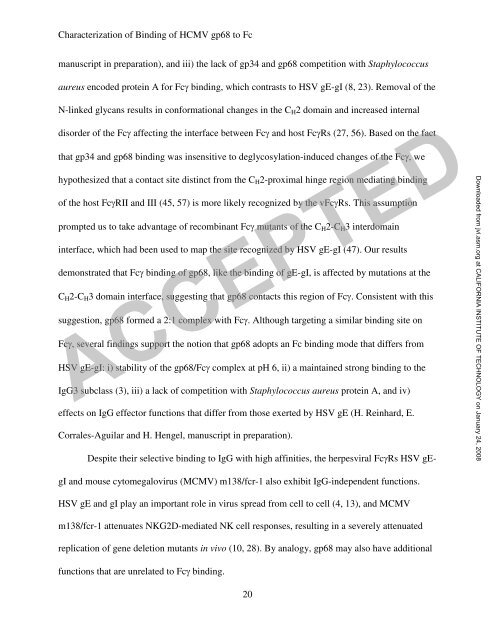The Human Cytomegalovirus Fc Receptor gp68 Binds the Fc CH2 ...
The Human Cytomegalovirus Fc Receptor gp68 Binds the Fc CH2 ...
The Human Cytomegalovirus Fc Receptor gp68 Binds the Fc CH2 ...
You also want an ePaper? Increase the reach of your titles
YUMPU automatically turns print PDFs into web optimized ePapers that Google loves.
Characterization of Binding of HCMV <strong>gp68</strong> to <strong>Fc</strong><br />
manuscript in preparation), and iii) <strong>the</strong> lack of gp34 and <strong>gp68</strong> competition with Staphylococcus<br />
aureus encoded protein A for <strong>Fc</strong>γ binding, which contrasts to HSV gE-gI (8, 23). Removal of <strong>the</strong><br />
N-linked glycans results in conformational changes in <strong>the</strong> C H 2 domain and increased internal<br />
disorder of <strong>the</strong> <strong>Fc</strong>γ affecting <strong>the</strong> interface between <strong>Fc</strong>γ and host <strong>Fc</strong>γRs (27, 56). Based on <strong>the</strong> fact<br />
that gp34 and <strong>gp68</strong> binding was insensitive to deglycosylation-induced changes of <strong>the</strong> <strong>Fc</strong>γ, we<br />
hypo<strong>the</strong>sized that a contact site distinct from <strong>the</strong> C H 2-proximal hinge region mediating binding<br />
of <strong>the</strong> host <strong>Fc</strong>γRII and III (45, 57) is more likely recognized by <strong>the</strong> v<strong>Fc</strong>γRs. This assumption<br />
prompted us to take advantage of recombinant <strong>Fc</strong>γ mutants of <strong>the</strong> C H 2-C H 3 interdomain<br />
interface, which had been used to map <strong>the</strong> site recognized by HSV gE-gI (47). Our results<br />
demonstrated that <strong>Fc</strong>γ binding of <strong>gp68</strong>, like <strong>the</strong> binding of gE-gI, is affected by mutations at <strong>the</strong><br />
C H 2-C H 3 domain interface, suggesting that <strong>gp68</strong> contacts this region of <strong>Fc</strong>γ. Consistent with this<br />
suggestion, <strong>gp68</strong> formed a 2:1 complex with <strong>Fc</strong>γ. Although targeting a similar binding site on<br />
ACCEPTED<br />
<strong>Fc</strong>γ, several findings support <strong>the</strong> notion that <strong>gp68</strong> adopts an <strong>Fc</strong> binding mode that differs from<br />
HSV gE-gI: i) stability of <strong>the</strong> <strong>gp68</strong>/<strong>Fc</strong>γ complex at pH 6, ii) a maintained strong binding to <strong>the</strong><br />
IgG3 subclass (3), iii) a lack of competition with Staphylococcus aureus protein A, and iv)<br />
effects on IgG effector functions that differ from those exerted by HSV gE (H. Reinhard, E.<br />
Downloaded from jvi.asm.org at CALIFORNIA INSTITUTE OF TECHNOLOGY on January 24, 2008<br />
Corrales-Aguilar and H. Hengel, manuscript in preparation).<br />
Despite <strong>the</strong>ir selective binding to IgG with high affinities, <strong>the</strong> herpesviral <strong>Fc</strong>γRs HSV gEgI<br />
and mouse cytomegalovirus (MCMV) m138/fcr-1 also exhibit IgG-independent functions.<br />
HSV gE and gI play an important role in virus spread from cell to cell (4, 13), and MCMV<br />
m138/fcr-1 attenuates NKG2D-mediated NK cell responses, resulting in a severely attenuated<br />
replication of gene deletion mutants in vivo (10, 28). By analogy, <strong>gp68</strong> may also have additional<br />
functions that are unrelated to <strong>Fc</strong>γ binding.<br />
20
















